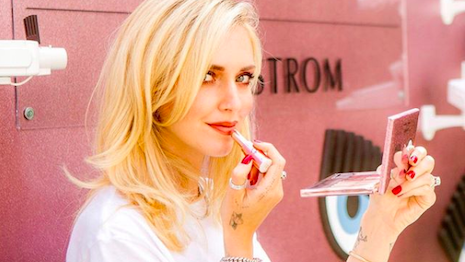 Barneys spotlights influencers like @your.gal.shan on its blog. Image credit: @your.gal.shan
Barneys spotlights influencers like @your.gal.shan on its blog. Image credit: @your.gal.shan
Although social media engagement has declined, interactions on influencers’ sponsored Instagram posts outpace non-sponsored content, underscoring the importance of authenticity in influencer marketing.
According to InfluencerDB’s 2019 Influencer Marketing Benchmarks Report, the average ratio of likes to followers declined from 2018 across sectors. In most countries, engagement from sponsored Instagram posts also outperforms non-sponsored posts as organic reach decreases.
“Engagement rates have steadily dropped over the years and recently reached a plateau, giving marketers a clear understanding of what success can and should look like for their teams,” said Mona Hellenkemper, director of marketing at InfluencerDB, Koln, Germany. “It’s important to remember that data refers to people and to always consider the end user when launching a campaign.”
InfluencerDB’s report is based on approximately 307,000 accounts in its marketing cloud. Engagement was tracked from Q1 2016 to Q1 2019.
Engagement and ROI
Every vertical evaluated by InfluencerDB – beauty, fashion, food, lifestyle, sports and fitness – saw declines year-over-year in engagement, or the like-follower ratio (LFR).
Travel influencers have the highest engagement rates at an average of 4.5 percent, but this is still a significant decline from an LFR of 8.0 percent in 2018.
 Nordstrom celebrated the launch of Lancôme’s Chiara Ferragni capsule collection. Image credit: Nordstrom
Although beauty influencers tied with food influencers with the lowest engagement at 3.2 percent, they account for 7 percent of Instagram’s total sponsorships. Fashion influencers are responsible for a quarter of Instagram’s sponsorships, while travel influencers only account for 5 percent despite the higher “like” levels.
LFR is also higher among influencers with smaller audiences.
“Nano-influencers,” who have between 1,000 and 5,000 followers, average an 8.8 percent engagement rate. Accounts with audiences between 5,000 and 10,000 users follow nano-influencers, with an average LFR of 6.3 percent.
Once influencers reach 10,000 or more followers, engagement hovers around the same rate – between 3.4 and 3.8 percent.
Marketers continue to work with influencers for a variety of reasons, including increasing brand visibility and lead generation. Although overall engagement has declined on all types of content since 2016, InfluencerDB found that the global LFR of sponsored posts is 2.4 percent compared to 1.9 percent for non-sponsored posts.
Nordstrom celebrated the launch of Lancôme’s Chiara Ferragni capsule collection. Image credit: Nordstrom
Although beauty influencers tied with food influencers with the lowest engagement at 3.2 percent, they account for 7 percent of Instagram’s total sponsorships. Fashion influencers are responsible for a quarter of Instagram’s sponsorships, while travel influencers only account for 5 percent despite the higher “like” levels.
LFR is also higher among influencers with smaller audiences.
“Nano-influencers,” who have between 1,000 and 5,000 followers, average an 8.8 percent engagement rate. Accounts with audiences between 5,000 and 10,000 users follow nano-influencers, with an average LFR of 6.3 percent.
Once influencers reach 10,000 or more followers, engagement hovers around the same rate – between 3.4 and 3.8 percent.
Marketers continue to work with influencers for a variety of reasons, including increasing brand visibility and lead generation. Although overall engagement has declined on all types of content since 2016, InfluencerDB found that the global LFR of sponsored posts is 2.4 percent compared to 1.9 percent for non-sponsored posts.
Influencers are required to disclose sponsorships on Instagram The United States is a notable exception, with non-sponsored LFR edging out sponsored post engagement, 1.9 to 1.6 percent. Germany has one of the highest LFR, at 3.6 percent for both sponsored and non-sponsored posts, but this still represents a decline from a 10 percent LFR for sponsored content in the third quarter of 2016. These shifts come as Instagram is expanding brands’ advertising toolkits with an upcoming option that will allow companies to promote posts by celebrities and influencers. Intended to better serve advertisers and content creators, the Facebook-owned platform announced the new “branded content ads” on Mar. 5. Instagram and Facebook have continued formalizing their advertising options and guidelines (see story). Luxury influencers Influencer marketing continues to grow in the fashion, beauty and luxury businesses, as brands seek to reach the valuable millennial audience. According to research from marketing platform and data analytics company Launchmetrics, 80 percent of brands in these industries say they have used influencer campaigns in the past year, up from 78 percent last year. Among the brands leveraging influencer marketing, 78 percent say that their prime target is millennials (see story). Luxury brands continue to partner with influencers with millions of followers, despite data showing that under-the-radar influencers draw more engagement. Italian fashion brand Tod’s is looking to gain clout in China through a partnership with macro influencer Mr. Bags. Tod’s collaborated with Mr. Bags on a limited-edition unicorn bag. The influencer is known for widely popular joint limited-editions with brands and has also often worked with Tod’s in the past (see story). Similarly, L’Oreal-owned beauty brand Lancôme is launching the first-ever beauty collaboration for powerful influencer Chiara Ferragni. Known as the founder of The Blonde Salad, Ms. Ferragni is working with Lancôme to launch her own collaborative makeup line including eye shadow, lipstick, mascara and more. Exclusively available at Nordstrom, Lancôme is funneling Ms. Ferragni’s influencer clout into product sales (see story).View this post on InstagramMonday mood. @gasbijoux #GasBijouxLoveMarie #FrenchSavoirFaire #MadeInFrance #MadeWithLove
